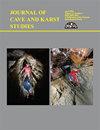新墨西哥州索科罗县寒武系-奥陶系Lemitar碳酸盐岩地质:重新考察
IF 0.5
4区 地球科学
Q4 GEOSCIENCES, MULTIDISCIPLINARY
引用次数: 0
摘要
碳酸盐岩是岩浆成因的火成岩,由50%以上的碳酸盐矿物组成,低于20%的sio2,它们可以形成含有大量稀土元素(REE),重晶石(Ba),萤石(F)和铌(Nb)的经济矿床。稀土是关键矿物,对信息时代技术的功能至关重要,因为它们具有独特的性质,如高导电性、强磁性、荧光和发光。碳酸盐岩是目前世界上稀土元素的主要来源。勒米塔尔山碳酸盐岩为轻稀土富集岩,总稀土元素(TREE)含量高达~1%。虽然以前已经描述过,但新的分析技术已经允许对它们的起源进行额外和更精确的描述、年龄和模型。40 Ar/ 39 Ar法和U/Pb法测定的Lemitar碳酸盐均为~515 Ma。岩石学观测结合全岩地球化学和同位素资料表明,Lemitar碳酸盐岩为幔源,与科罗拉多州南部和新墨西哥州地区寒武-奥陶系碱性火成岩和碳酸盐岩带有关。勒米塔尔碳酸盐岩吨位小,品位低,目前经济效益不佳。然而,需要钻探来确定它们是否增加了REE和Nb浓度(一个样品中1.1%的总REE是显著的)。需要详细的地球物理学来确定Lemitar山脉的地下是否可能有更大的碳酸盐岩。本文章由计算机程序翻译,如有差异,请以英文原文为准。
Geology of the Cambrian-Ordovician Lemitar Carbonatites, Socorro County, New Mexico: Revisited
Carbonatites are igneous rocks of magmatic origin that are composed of more than 50% carbonate minerals, less than 20% SiO 2 , and they can form economic deposits containing significant amounts of rare earth elements (REE), barite (Ba), fluorite (F), and niobium (Nb). REE are critical minerals and are critical to the functioning of information-age technologies because of their unique properties, i.g., high electric conductivity, strong magnetism, fluorescence, and luminescence. Carbonatites are currently the principal source of REE in the world. Carbonatites in the Lemitar Mountains are light REE enriched and contain as much as ~1% total rare earth elements (TREE). While previously described, new analytical techniques have allowed for additional and more precise description, age, and model of their origin. The Lemitar carbonatites from both 40 Ar/ 39 Ar and U/Pb methods are ~515 Ma. Petrographic observations combined with whole-rock geochemical and isotope data indicate the Lemitar carbonatites are mantle-derived and related to the regional Cambrian-Ordovician belt of alkaline igneous rocks and carbonatites in southern Colorado and New Mexico. The Lemitar carbonatites are not economic at the present time because of small tonnage and low grades. However, drilling is required to determine if they increase in REE and Nb concentrations at depth (1.1% total REE in one sample is significant). Detailed geophysics are required to determine if the Lemitar Mountains could have a larger carbonatite emplaced in the subsurface.
求助全文
通过发布文献求助,成功后即可免费获取论文全文。
去求助
来源期刊

Journal of Cave and Karst Studies
地学-地球科学综合
CiteScore
1.90
自引率
0.00%
发文量
6
审稿时长
>12 weeks
期刊介绍:
The Journal of Cave and Karst Studies is a multidisciplinary journal devoted to cave and karst research. The Journal is seeking original, unpublished manuscripts concerning the scientific study of caves or other karst features. Authors do not need to be members of the National Speleological Society, but preference is given to manuscripts of importance to North American speleology.
 求助内容:
求助内容: 应助结果提醒方式:
应助结果提醒方式:


